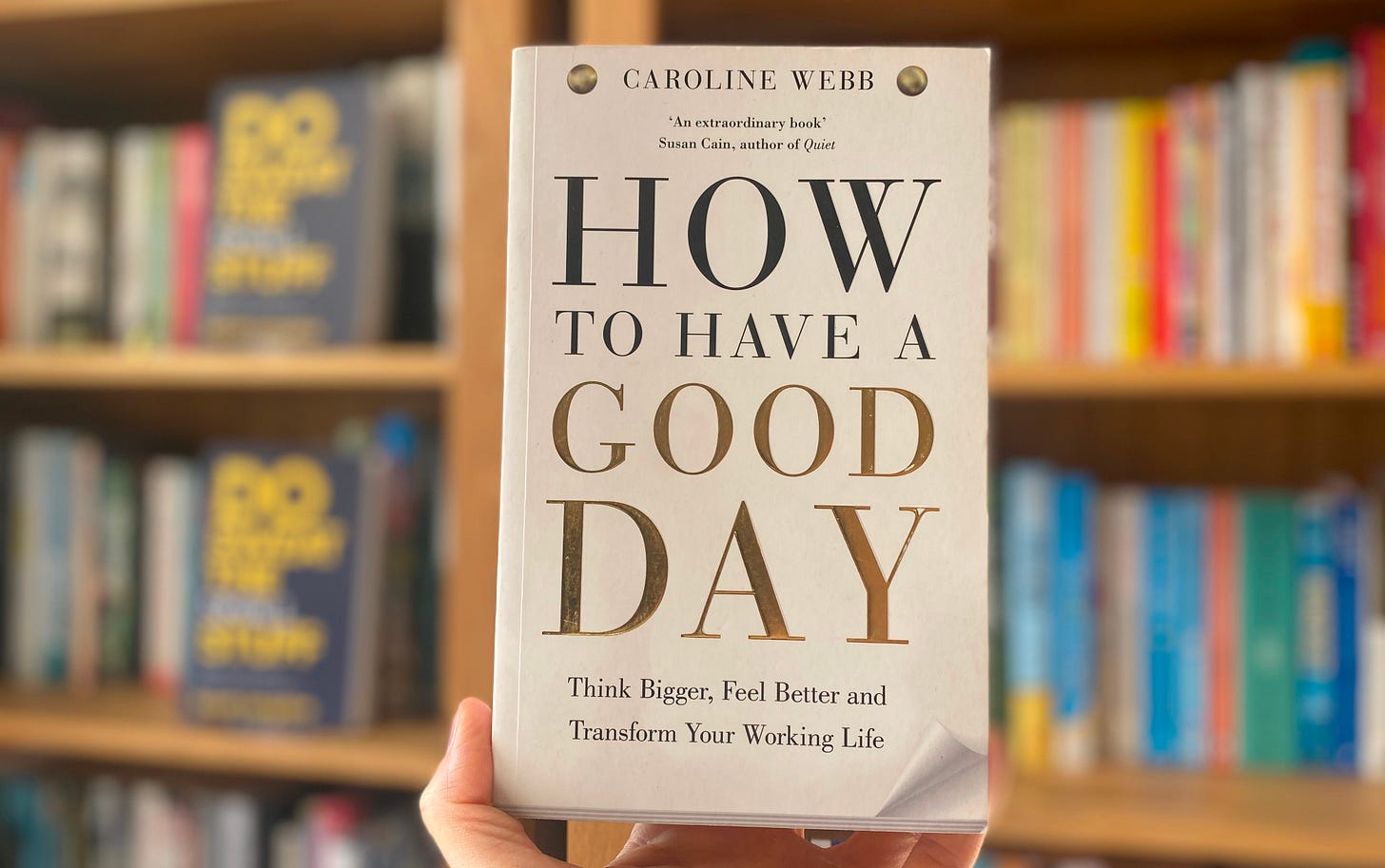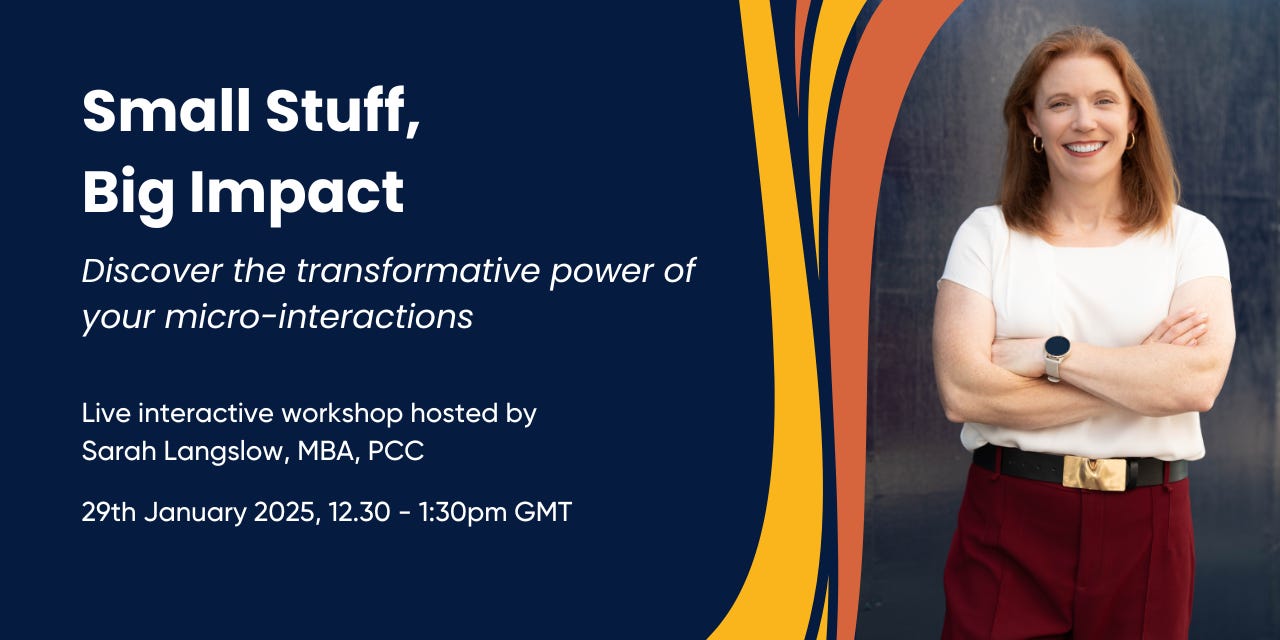How to Have a Good Day
This week in what I’ve been reading: using behavioural economics, psychology and neuroscience to transform our approach to our everyday lives, in How to Have a Good Day by Caroline Webb
This book does exactly what it says on the tin, if you’ll forgive me for borrowing an old advertising slogan. Relentlessly practical, and absolutely packed with neuroscience-backed strategies for improving how you approach your daily tasks and routines, this is a handbook to help you have a good day, every day. Sometimes we want books that make us think deeply, but sometimes we just want one that gives clear, useful, actionable advice – How to Have a Good Day is that book.
What’s it all about then?
It’s about how to have a good day. 😁
Oh, you wanted more than that? OK then.
How to Have a Good Day opens with an introduction to some essentials of neuroscience, described in three themes which underpin the rest of the book.
First is one you’re likely already familiar with: our two-system brain. One slower, deliberate, controlled and intentional system, and one faster, automatic and instinctive. The combination of the two is what makes us who we are as humans, and learning to work with both systems and harness their strengths is key (a similar theme to that explored in The Chimp Paradox).
Second is the so-called discover-defend axis. This acknowledges that we are always on the lookout for threats to defend ourselves against. We are not at our smartest in this defensive mode, so the more we can be aware that we are in it, and switch back into clearer-thinking discovery mode, the better we can function.
Third is the mind-body loop. This recognises how intertwined our bodies and minds actually are, with the implication that certain physical interventions can enhance our intellectual performance, emotional resilience and personal confidence.
The core of the book is then split into seven parts, looking at different aspects of self-management. Each draws on the themes of neuroscience above, and lays out comprehensive and practical suggestions and approaches for being at your best. They are all comprehensively referenced, and Webb uses plenty of examples and short stories to illustrate her points.
The seven parts are:
Priorities – Setting intentional direction for your day
How to set great goals, how to support and reinforce (good) intentions, and the impact of choosing our filters, effectively giving our autopilot good directions.Productivity – Making the hours in the day go further
Why we need to single, not multi-task, the value of planning deliberate downtime, how we overcome overload and strategies for beating procrastination.Relationships – Making the most of every interaction
Ways to build real rapport, resolving tensions, including through understanding and addressing unmet needs, and knowing your own “hot buttons”, and ways to bring the best out of others.Thinking – Being your smartest, wisest, most creative self
Getting out of feeling bogged down to reach new insight, approaches to decision-making and ways to spot you might not be in a position to make good decisions, and how to boost your brainpower for moments when you need to be at your best.Influence – Maximising the impact of all you say and do
Strategies to maximise your impact, increase your chances of being listened to, ways to be persuasive, and how to cultivate confidence, even if you don’t feel it.Resilience – Sailing through setbacks and annoyances
What you need to keep your cool, let go and move on, and how to maintain your strength.Energy – Boosting your enthusiasm and enjoyment
Tactics to life your mental, emotional and physical energy, or give you a boost when you’re in need of it, and strategies to create a deeper, longer-lasting enthusiasm for your work.
The final postscript looks at how to make these changes stick, and the appendices give specific practical suggestions on how to be good in meetings, on email, and how to create a great routine.
What are the highlights?
This book thoroughly satisfied the part of me that just wants to know how to do things. This isn’t really about mindset or thinking yourself differently. It is page after page of suggestions that you can go and take action on right now, today.
I appreciated the layout. You could read this book cover to cover, but you could equally dip into the sections that you struggle with and focus on those. The chapter summaries provide an overview that can help you decide if you want to read that chapter. And even within chapters, it would be easy to pick out sections relevant to you. All that makes this book very easy to work with, so while it is quite dense, it is also accessible.
That all of Webb’s advice is underpinned by psychology, behavioural economics and neuroscience was also reassuring. This wasn’t simply one person’s idea of what works, her suggestions are backed by research. In a world where so many are trying to persuade you that they alone have the answer, this analytical basis was welcome.
And, if you’ve read my own book, Do Sweat the Small Stuff, you’ll probably understand why I enjoyed this. Much of what is suggested feels simple and small, yet can have a disproportionately large impact, both on ourselves and others.
Anything you didn’t like?
The book does at times come across a little too instructional – “do this, don’t do that” etc. Whatever the research says, ultimately the thing that works is the thing that works for you. If that runs contrary to the majority, so be it. You do you.
I have an open question on how this book might land with those who are neurodiverse. I would imagine that the research cited is for the most part based on those who are more neurotypical so I’m unclear how and whether the advice contained might translate. Webb could, and probably should, have addressed this more clearly. To my neurodivergent subscribers who read this (or have read it) I’d be interested in your thoughts.
And finally, you may read this and think none of this is particularly new and much of it is fairly obvious, which could put you off. For me, I’m well aware there’s plenty I already know about that I could (should…) be doing that I’m not. So, the reminder is useful. When I’m in my “stuff” sometimes I just need to be kindly bashed on the head with the blindingly obvious to remind me that there’s a lot I can do for myself to make things better. That might just be me, but I doubt it. And this book does just that.
Why should I read it?
If you’re looking for practical actions to improve your productivity, your relationships, your influence and your impact, this is a valuable reference book that you might find yourself turning to repeatedly.
If you’re a bit of a science nerd (*waves*) fascinated by the workings of our brains and how to harness that to your advantage, you’ll probably enjoy this too.
What’s the one thing you’ll do differently as a result of reading this?
I’m revisiting how I plan my days, my weeks, and my quarters. I’m frequently overambitious, so I tend to spend my entire time feeling behind. This quote felt a little like a personal attack, but neatly sums up why…
“Another reason so many of us often feel overloaded is because of something called the planning fallacy. This describes the fact that we typically expect tasks to take less time than they actually do, because we base our estimates on one standout memory – our best past experience – rather than the average time it’s taken us to do similar tasks in the past.”
Time for me, in the nicest possible way, to get real!
How to Have a Good Day: Harness the Power of Behavioral Science to Transform Your Working Life
by Caroline Webb, Published by Macmillan in 2016.
Available at Amazon UK, Amazon US, or Bookshop.org. (#aff links)
Have you read How to Have a Good Day? I’d love to hear what you thought, so click here to add a comment or your own review:
Join me in January for Small Stuff, Big Impact
If you missed the last one, it’s back! I’m running another Small Stuff Big Impact Workshop on 29th January at 12.30pm GMT.
Unlock the hidden power of small, everyday interactions with "Small Stuff, Big Impact: Discover the transformative power of micro-interactions" – this live, online (and complimentary) workshop will introduce you to the world of micro-interactions – those small, seemingly inconsequential moments that have a profound impact on your team’s engagement and performance. If you’re leading or managing others, mastering these moments is essential to building stronger relationships and creating a more motivated, connected team.
In this 60-minute introductory workshop, you will:
🌟 Learn what micro-interactions are and why they matter in leadership.
🌟 Discover how small adjustments in communication, tone, and behaviour can create a ripple effect, transforming your daily interactions into powerful tools for engagement.
🌟 Learn how to translate theory into action – you will leave with practical suggestions to start making subtle but effective changes right away.
Register for your place via this link, and please do share with anyone you know who might like to join.
Places are limited to ensure a truly interactive discussion, so sign up now to avoid missing out.
See you there!
If you know someone else who might enjoy this, click here to send it to them directly:
Thank you!





